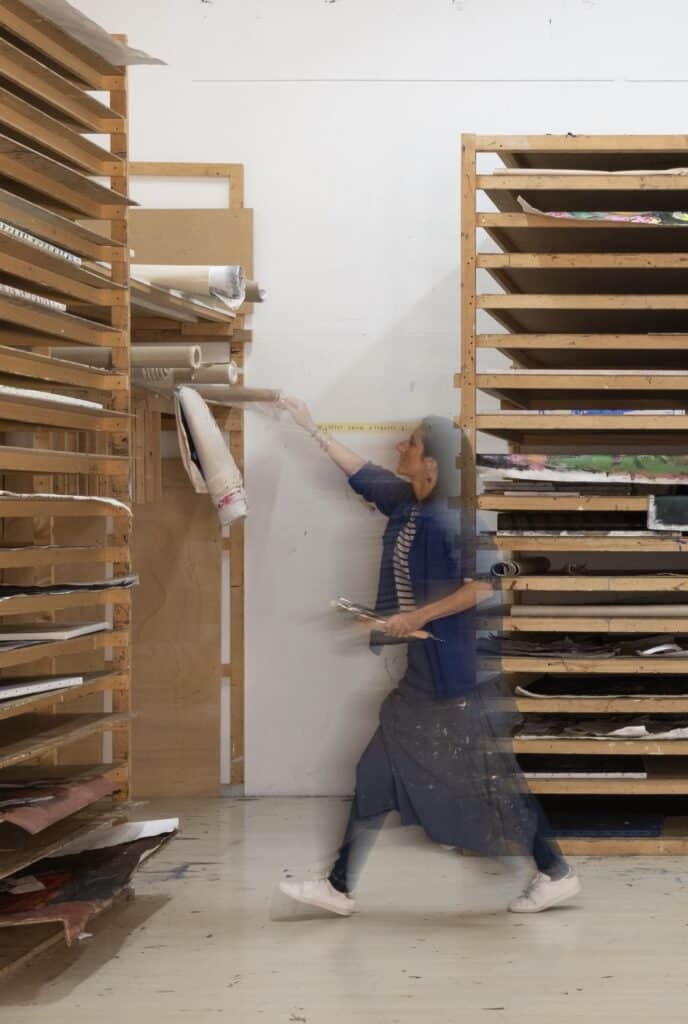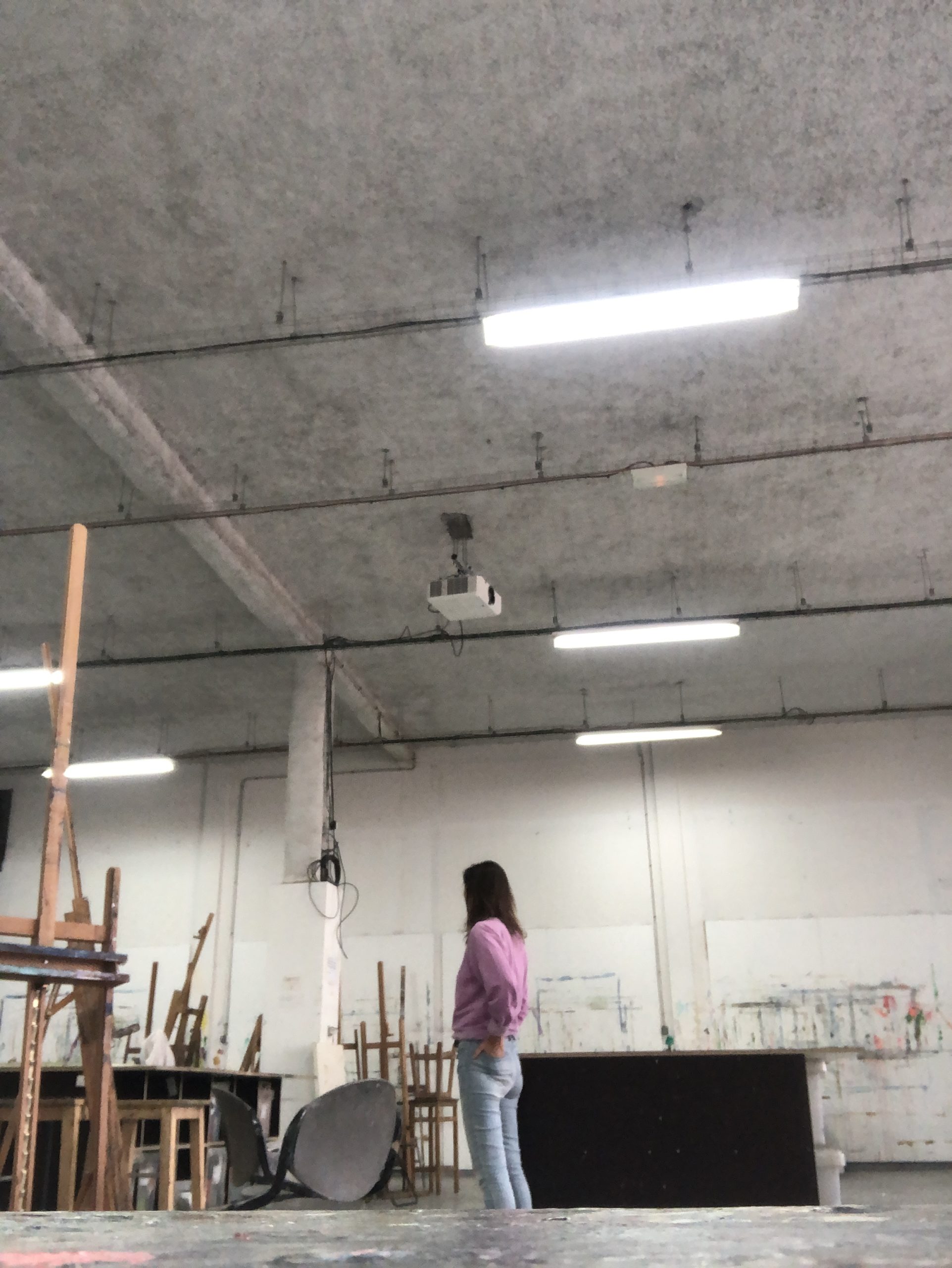
Démarche artistique
Comment les espaces ou objets intimes, que nous côtoyons, traversons, nous habitent-ils ? Quelle empreinte laissent-ils en nous?
A la manière de Georges Pérec dans son essai Espèces d’espaces (1974), je cherche à sortir l’espace et les objets qui le composent de l’anesthésie du quotidien.
Explorer l’empreinte, la mémoire sensorielle et chromatique. Lire l’espace.
Apprivoiser les lieux.
Faire émerger un portrait sensible de ces espaces et de certains objets qui le composent.
Mes oeuvres sont un miroir inversé de l’agitation de nos existences et une invitation à initier un autre rapport au monde, qui passe par l’attention. Elles traduisent dans une pratique plastique ce que Gaston Bachelard nomme « la conscience rêveuse ».
Une poétique de l’espace.
« Le problème n’est pas d’inventer l’espace, encore moins de le réinventer mais de l’interroger ou plus simplement de le lire, car ce que nous appelons quotidienneté n’est pas évidence mais opacité : une forme de cécité, d’anesthésie »
Georges PEREC, Espèces d’Espace (1974)

Artiste pluridisciplinaire, Pazanne vit entre Paris et les lieux où ses projets la conduisent.
Son travail se déploie comme une topographie sensible.
A côté de sa pratique de peintre, dessinatrice et graveur, elle développe aujourd’hui des projets de fresques murales, de livres d’artiste, et de céramiques.
Elle expose régulièrement en France et à l’étranger et participe à des Salons (Salon de Charenton, Journées de l’estampe contemporaine à Paris).
Diplômée en sciences politiques et langue et littérature anglo-saxonnes, Pazanne s’intéresse durant ses études aux questions de restauration de monuments historiques en France et à l’étranger. Elle y consacre un mémoire. Puis pendant 20 ans, dans les relations institutionnelles, elle apprend à déchiffrer et analyser visuellement l’environnement dans lequel elle évolue. D’un Ministère à un bureau de conseil, d’une ONG à l’hémicycle du Palais Bourbon, elle consigne régulièrement en croquis ou par écrit l’anecdotique des lieux et situations. Le soir, en parallèle, elle se forme au dessin et à la peinture. Et à partir de 2008, elle commence à exposer son travail.
En 2021, elle décide de se consacrer exclusivement à sa pratique artistique ; troque le monde de l’écrit et de la parole pour le visuel. Passe de l’ostensible à l’intime, du bruyant au silencieux, du remarquable au banal. Progressivement elle épure ses représentations.
Ses sujets empruntent à la littérature et à des questionnements plus politiques qui traversent de façon sous-jacente ses oeuvres : une esthétique et un combat pour la préservation du paysage, un questionnement sur le cadre de vie.
Elle conçoit sa pratique artistique avant tout comme une expérience, et un champ de découverte non seulement spatial mais humain. Ses projets la conduisent régulièrement sur le pourtour Méditerranéen d’ où elle est originaire, en Italie où elle a vécu, et en Grèce. Membre de collectifs d’artistes – notamment le Cercle de l’Art- elle crée au sein de structures collectives et de tiers-lieux. Son atelier est aujourd’hui au 100 ECS.
Elle organise et participe régulièrement à des résidences d’artistes en France et à l’étranger (au Maroc, Massastories, en Bretagne, dans le sud de la France, et à Tinos en Grèce).
Ce qui reste, par Stéphane Lambion
assis sur une chaise, à une table, près d’un mur, ou à même le sol : on est invité aussitôt. on se glisse dans un réseau brut et travaillé à la fois – un réseau de lignes, vues dans un miroir, à travers un rideau, par une fenêtre, les yeux plissés : une construction aussi précise qu’elle est floue, comme le souvenir d’une sensation qui nous ramène exactement à son origine sans qu’on ait la moindre idée du chemin par lequel on y est arrivé. c’est-à-dire : une topographie sensible : un dessin d’architecte sur lequel on a superposé des feuilles de papier calque froissées qui, parce qu’elles sont là, permettent de mieux comprendre ce qui est en dessous. pas de visages, pas de figures : au mieux des fantômes, et le regard du peintre, mais ce qui compte, toujours c’est l’espace : physique, matériel, concret, qui raconte une histoire par une chaise, un lit, puis un pan de mur, et encore un bout de plancher : des pièces élémentaires, recadrées, agrandies, qui forment un puzzle de touches à recoller pour qu’apparaisse peut-être, mais seulement à la toute fin, la toile d’une existence obtenue par la somme diffuse de ses espaces vécus. ceux ordinaires, ressentis avant que d’être observés : une texture, une hauteur, un angle, une lumière. des espaces qui, parce qu’ils se fondent les uns dans les autres, parce qu’on n’en saisit que de minuscules parcelles, n’en sont que plus nets et plus précis. l’important, dès lors, n’est pas ce que l’on voit, mais ce qui reste après avoir tout vu : la construction, touche par touche, de notre perception de cet espace où l’on a été invité, et que l’on peut – à notre tour – habiter.
Stéphane Lambion est écrivain et artiste. Il vit à Londres.
Artistic Approach
How do the intimate spaces and objects we encounter, pass through, inhabit us? What imprint do they leave on us?
Like Georges Pérec in his essay "Espèces d'espace" (1974), I seek to free space and the objects that compose it from the anesthesia of everyday life.
Exploring the imprint, sensory and chromatic memory. Reading space.
Taming places.
Creating a sensitive portrait of these spaces and certain objects that compose them.
My works are an inverted mirror of the agitation of our existence and an invitation to initiate a different relationship with the world, one that involves attention. They translate into a visual practice what Gaston Bachelard calls "dreamy consciousness."
A Poetics of Space
Biography
A multidisciplinary artist, Pazanne lives between Paris and the places where her projects take her.
Her work unfolds like a sensitive topography.
In addition to her painting, drawing and printmaking works, she currently develops projects involving murals, artist's books, and ceramics.
She exhibits regularly in France and abroad and participates in collective shows (Salon de Charenton, Journées de l'estampe contemporaine in Paris).
With degrees in political science and Anglo-Saxon language and literature, Pazanne became interested in the restoration of historic monuments in France and abroad during her studies. She wrote a dissertation on the subject. Over the next 20 years, working in institutional relations, she learned to visually decipher and analyze the environment in which she operates. From a Ministry to a consultancy firm, from an NGO to the hemicycle of the Palais Bourbon, she regularly records the anecdotal details of places and situations in sketches or in writing. In the evenings, at the same time, she trains in drawing and painting. And from 2008, she began exhibiting her work.
In 2021, she decided to devote herself exclusively to her artistic practice, swapping the world of writing and speech for the visual. She moved from the ostensible to the intimate, from the noisy to the silent, from the remarkable to the banal. Gradually, she refined her representations.
Her subjects borrow from literature and from more political questions that run through her works: an aesthetic and a fight for the preservation of the landscape, a questioning of the living environment.
She sees her artistic practice above all as an experience, and a field of discovery not only spatial but also human. Her projects regularly take her to the Mediterranean region, where she is originally from, to Italy, where she has lived, and to Greece. A member of artist collectives—notably the Cercle de l'Art—she creates within collective structures and third places. Her studio is currently located at 100 ECS.
She regularly organizes and participates in artist residencies in France and abroad (in Morocco, Massastories, Brittany, the south of France, and in Tinos in Greece).
